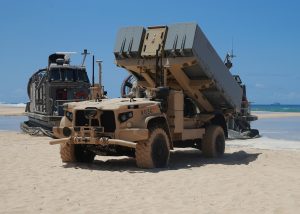The U.S. military has plans to leave a powerful anti-ship missile system in the Philippines after the conclusion of the upcoming joint military exercises in preparation for another exercise the following month.
In a report published yesterday, Stars and Stripes quoted a U.S. Marine Corps spokesperson as saying that the corps would leave the Navy-Marine Expeditionary Ship Interdiction System (NMESIS), which is being deployed in the Philippines for the Balikatan military exercises, would remain behind until the Kamandag exercise in June. Seventy-five marines will remain in the country along with the NMESIS systems, the spokesperson added.
Often described as a “ship killer” missile, NMESIS is a potent ground-based, mobile anti-ship missile system that was developed for the U.S. Marine Corps. According to Naval News, NMESIS will “allow units such as Marine Littoral Regiments (MLR) to deny coastal areas and other key chokepoints to the enemy.”
The deployment follows several years of intensifying tensions in the South China Sea, where China has increased both the frequency and intensity of its incursions into waters claimed by the Philippines. This has resulted in a string of perilous confrontations that have seen China Coast Guard vessels ram Philippine ships, or douse them with high-pressure water cannons.
During his visit to the Philippines late last month, Defense Secretary Pete Hegseth condemned China’s recent belligerence and announced that the U.S. would deploy “more advanced” U.S. defense equipment in the Philippines, including NMESIS, which he said would arrive in the country ahead of Balikatan. Ten thousand U.S. troops will participate in the drills, which are due to run from April 21 to May 4, alongside 6,000 service members from the Philippines, Australia and Japan.
Kamandag, an annual bilateral exercise designed to strengthen interoperability between the Armed Forces of the Philippines and the U.S. military, will be held in June. During the last Kamandag drills in October, more than 1,000 U.S. Marines and 1,100 Filipino troops took part in coastal defense operations and other drills. Smaller contingents from Japan, South Korea, Australia, and the United Kingdom also took part.
The plans replicate the U.S. military’s deployment last year of the Typhon intermediate-range missile system, which was similarly deployed for Balikatan and then remained in the country. Late last year, the Philippine Army announced that it was in negotiations to acquire the Typhon system, which can fire Tomahawk Land Attack Missiles capable of striking targets in mainland China, in order to strengthen the country’s external defenses.
Stars and Stripes quoted Ralph Cossa, the former president of the Pacific Forum think tank, as saying that deploying weapons to the Philippines for exercises and leaving them there for extended periods was a means of strengthening deterrence against China, amid its ongoing tensions with the Philippines in the South China Sea.
Certainly, Beijing was far from happy with the deployment of the Typhon system. After last year’s deployment, China’s government has repeatedly urged the Philippines to withdraw the system, describing it variously as “an extremely irresponsible choice” that “undermines regional peace and stability.” Based on this precedent, it would not be a surprise if the NMESIS system remained deployed on Philippine soil beyond June.

































